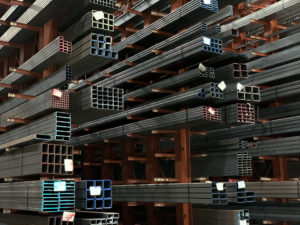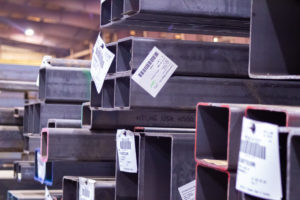What is the Difference Between Pipe and Tube? Part Two
Pipe vs tube – the battle between two of the most versatile steel products continues. In case you missed it, last month, we walked you through everything you wanted to know about steel pipe. This month, we will take a deep dive into steel tube, the common specifications, the proper way to order tube and how you can partner with Contractors Steel for all of your steel tube needs.



Pipe vs Tube – What is steel tube?
Steel tube has many names but there is one common denominator with the product – it’s hollow. In fact, steel tube is often referred to by fabricators and engineers as “HSS”, or “Hollow Structural Sections”. Furthermore, tube can be used in countless applications – from the handrails you hold when exiting a stadium, to supporting long-span warehouses. In fact, tubing is such a versatile product, it can be found in countless industries. These include:
- Nonresidential construction
- Agriculture
- Infrastructure
- OEMs
- Construction
- Transportation
When would you use steel tube?
As we have mentioned, steel tube is a versatile structural steel product ideal for many applications. In general, you will select a steel tube when you need one of the following characteristics:
- A high strength to weight ratio that reduces the amount of steel you need
- Your design will be architecturally exposed – with smooth sides, steel tube is usually an architect’s first choice for structural steel
- Less surface area for your coatings – tube has approx. 2/3 less surface area which requires less painting
- Closed section – designed to resist torsional loads as well as dust collection in clean facilities
What are common specifications for steel tube?
When you order a steel tube, it is important to take note of the final application it will be going into. For instance, if your application will be in a commercial application such as a lawn mower handle, you will want to consider an ASTM A513 tube. But, if you need a tube for a load bearing application, ASTM A500 is the way to go. In fact, ASTM A500 and ASTM 513 are the two most common steel tube specifications currently in the market.
What is ASTM A500 tubing?
ASTM A500 is a specification that applies to structural tubing in three common shapes: squares, rectangles, or rounds. In fact, ASTM A500 tubes are used in applications where load-bearing applications are required. Furthermore, when you order ASTM A500 tubing from your service center, you should be supplied with an MTR, or Material Test Report, that not only shows the chemical composition of the steel coil used to manufacture the tube, but also the Yield, Tensile and Elongation properties.
Pipe vs Tube – ASTM A500 Grade and Specifications
The most common ASTM A500 Grade in the marketplace today is Grade C. In addition, ASTM A500 Grade B is also commonly specified. One thing to note with both ASTM A500 and ASTM A513 tubes – the inside diameter is not measured and is therefore not guaranteed in any specification. Furthermore, a unique aspect of structural tube is that the specifications for rounds and shapes are different.
Chemical Requirements
| Element | Grade B | Grade C | ||
| Heat Analysis | Product Analysis | Heat Analysis | Product Analysis | |
| Carbon, max | 0.26 | 0.30 | 0.23 | 0.27 |
| Manganese, max | 1.35 | 1.40 | 1.35 | 1.40 |
| Phosphorus, max | 0.035 | 0.045 | 0.035 | 0.045 |
| Sulfur, max | 0.035 | 0.045 | 0.035 | 0.045 |
| Copper, min (when specified on PO) | 0.20 | 0.18 | 0.20 | 0.18 |
Tensile Requirements – Round Structural Tubing
| Grade B | Grade C | |
| Tensile strength, min psi | 58,000 | 62,000 |
| Yield Strength, min psi | 42,000 | 46,000 |
| Elongation in 2” min, % | 23 | 21 |
Tensile Requirements – Shaped Structural Tubing
| Grade B | Grade C | |
| Tensile strength, min psi | 58,000 | 62,000 |
| Yield Strength, min psi | 46,000 | 50,000 |
| Elongation in 2” min, % | 23 | 21 |
What is ASTM A513 tubing?
ASTM A513, or mechanical tubing, are used in more consumer-based applications that need tighter tolerances but are not concerned with the load-bearing properties of the material itself. Generally speaking, ASTM A513 applications are numerous and can include lawn mower handles, the legs on a bar stool or restaurant chair and specific parts used in recreational vehicles (such as a handle). Although not load-bearing, you will find most ASTM A513 tube applications are meant to be handled or held given the application they are designed for.
Pipe vs Tube – How do you typically order steel tube?
When you order a steel tube, you will list out the dimensions of the size you need, the gauge or thickness, and then the length (supplied in inches or feet). In addition, you need to provide the specification of the tube since some sizes can be either ASTM A500 or ASTM A513. Furthermore, sometime you order with the decimal or the gauge – either way is correct. Some of the more common ways to order include:
- 1 x 1 x .120 x 240”, A513
- 1 x 1 x 11ga x 20’, A513
- 2”x2” x .250” x 20’, A500
- .5x.5 -16ga P&O x 288”, A513
- 10×10 x .625” x 48’, A500
Since tube also comes in round shapes, it is often referred to as “pipe size tube”. Typically, a round tube is ordered to the standard NPS sizes and lengths – as an example, 1.25sch40 x 21’. In fact,it can also be ordered by its true size: 1.66” x .140” x 252”, A500. In addition, round tube comes in a wider range of sizes than a traditional “pipe”. Common tube rounds include:
- 5 x .188 x 20’, A500
- 3” x .250” x 24’, A500
- 5” x ¼ wall x 20’, A500
How do I know when I need “tube” instead of a “pipe”?
Stay tuned to our next blog in the “Pipe vs Tube” series for the answer to this often-asked question!
Partnering with Contractors Steel
Did you know, when you partner with Contractors Steel, you have access to ALL of our processing capabilities? This includes:
- Plate processing, including laser and oxy-fuel
- Coil Leveling
- Press braking
- Sawing
- Angle Master
- T-Splitting
- Plate Rolling
- Python
- And More!
Most importantly, at any of our locations, we stock only the highest quality steel products, all backed by material test reports from the mill. This includes:
- Beams
- Tube (HSS)
- Structural Pipe
- Angles
- Channels
- Sheet
- Plate
- And more!
Finally, we have several new products that we are stocking, including rebar and P&O sheets! Remember, contact our sales team today and find out how Contractors Steel takes the guesswork out of your supply chain.
